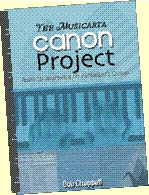The Musicarta Canon Project
Transposing the Canon Chord Sequence
- Part One -
The ability to transpose – to change the key of some music in your head and play it higher or lower than the original – is one of the things that defines a really proficient musician. Most professional musicians, both modern and classical, can transpose – some astonishingly well.
You can really only say you know a chord sequence, or a tune, or a riff, when you can transpose it. This works the other way round – if you really want to know a tune, or a riff, or a chord sequence, try transposing it. You soon start to see the relative size of the steps between the notes or chord roots, plus many other pattern features, and this will make it a lot easier to remember.
Younger pupils’ ability to learn to transpose is generally underestimated. The spin-off in terms of skill and progress of regular practise in transposing is significant, if hard to attribute precisely.
This is the Part One of the Musicarta Canon Project three-module 'Transposing' mini-series. It is intended for players who have completed the study programme - and for anybody else who is able to follow it.
The Musicarta Canon Project teaches you how to play a chord sequence freely and put together your own unique Canon keyboard performance from easily-mastered musical components.
|
The CANON PROJECT Pachelbel’s Canon in D is perhaps the most famous chord sequence of all time, and the basis of dozens of popular hits. If you can play and understand the Canon chord sequence, there isn’t much in popular music harmony you won’t be able to figure out! Its regular structure also makes it a great springboard for improvising and composition. |
|
Now available from Amazon Books
Click through to the Canon Project YouTube playlist here
The Roman numeral system of naming chords
The Roman numeral system (RNS) of naming chords uses Roman numerals to refer to the chords, not just of one key, but of any key. It is therefore extremely helpful in transposing. Take the trouble to understand this way of naming chords, because by doing so can use the chord sequences you learn this way in any key, and the system also helps you learn ‘how harmony works’.
The Romans wrote numbers like this.

Check that you understand how the system works. You add up ‘ones’ to three, four is ‘one before five’ (represented by V), then you add ones to five until nine, which is ‘one before ten’ (X). Write the numbers out forwards and backwards, then the even numbers and the odd numbers, and so on.
The chords of C major in the RNS
Here is a C major scale – the white keys from C to C. Note names are given below, and the ‘scale degree’ numbers (the steps of the scale) above.

| CPM_T1_01 |
Now look at the simple chords (triads) we can build on each step of the scale using just the C major scale degrees by playing every other white key. (These chords are named after the lowest note.)

| CPM_T1_02 |
It turns out that some of the chords built from the C major scale tones are major (C, F and G), and some are minor (D minor, E minor and A minor – Dm, Em and Am), depending on whether the middle note – counting in semitones – is closer to the top note or the bottom note of the triad. (One chord, which we ignore for now, is a third type, called the 'diminished'.)
To use the Roman numeral system (RNS) to designate (stand for) the chords, we have to adapt it to show the difference between major and minor chords.
Major and minor chords in the RNS
The Roman numerals given in the first table in this module are 'CAPITALS', or 'UPPER CASE'. We use these to designate major chords, and 'lower case' Roman numerals to designate minor chords.

So we designate our seven different chords as follows:

This combination of major and minor chords is true for every major key.
- The chords built on the first, fourth and fifth scale degrees are always major (I, IV, V)
- The chords built on the second, third and sixth scale degrees are always minor (ii, ii and vi)
- The triad built on the seventh scale degree is always diminished (indicated by the small circle after the lower case viiº).
Once you've practised using the Roman numeral system for a while, you start to think like this:

You would be thinking:
-
“In the key of C (or, in fact, any key), ‘One’ is major (C major), ‘Two’ is minor (D minor), ‘Three’ is minor (E minor), ‘Four’ is major (F major)…”
…and so on. This understanding of ‘key’ is hard to achieve any other way.
The chords of D major in the RNS
You have been playing the Canon in D major, its original key.
The key chords of D major follow the same major/minor (I, ii, iii, IV, V, vi) pattern as every major key. Here’s how they look side by side with the chords of C major.
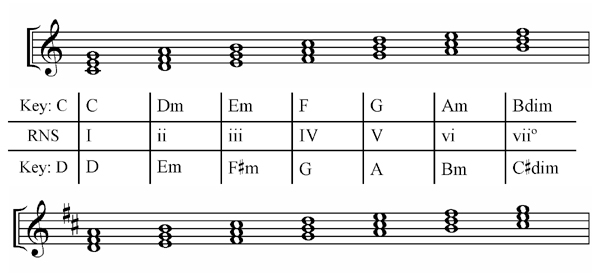
| CPM_T1_03 |
Try to copy the audio performance file. Work done playing scales pays off here, helping you remember the F and C sharp s of the D major key signature.
Transposing the Canon chord sequence into F
We are going to transpose the Canon chord sequence from D major into F major.
Revise the key of F (key signature, B flat), both scale and chords.
Make a transposing table for D major to F major

| CPM_T1_04 |
Listen to and copy the audio/MIDI performance files to make sure you can play the key chords in both keys. You play the eight triads in D, then in F, then in D and in F again.
The Canon chord sequence in D major is:
Using the transposing table above, we see that the Canon chord sequence in RNS chord symbols is:
(If you play the roots of the chords in this RNS chord sequence, you will hear the familiar Canon bass line.)
Read off the Canon chord sequence from the RNS chord symbols in the middle row of the table into Canon-in-F major chords in the bottom row:
Don’t try to play the chords just yet. Play just the roots of the chords (the name-notes in the chords symbols) with the left hand, and you will hear the familiar Canon bass line, only in the key of F.
Left hand accompaniment in F major
Using just the scale tones of F major (white keys except B flat), you are going to build root, fifth, octave, tenth (R, 5, 8, 10) accompaniment ‘ladders’ on the roots of the Canon-in-F-major chord sequence:
But if we follow our usual zigzag bass line, we will be starting too high (or going too low), so use low F both times.
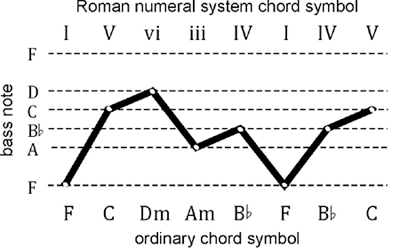
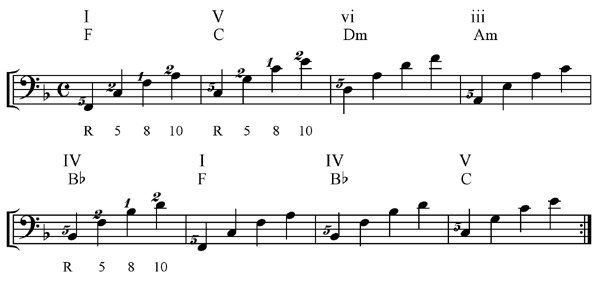
Transposing the right hand parts
The Roman numeral system works well for transposing chords, but transposing the right hand parts requires a different approach.
Look at our original string of thirds in D major:

| CPM_T1_06 |
The numbers above the notes are neither fingering, nor chords – they are the numbers of the D major scale degrees, counting up from D (here indicated by R for root). Make sure you can see how the numbers relate to the D major scale before going on.
NOTE: ALL the numbers refer to D major scale tones, regardless of what the chord is. Count up from D = R = 1, always.
Here is the same information in the key of F major:

| CPM_T1_07 |
Now you are counting up from F = R = 1. Your biggest challenge in transposing to F is to remember which black keys to play. You change from F sharp and C sharp in D major to just B flat in F major.
Here are the two versions with the black keys ringed:

| CPM_T1_08 |
Play through the two strings of thirds one after the other. There are far fewer black-key notes in the F major version.
Now put the thirds in F and the accompaniment together:
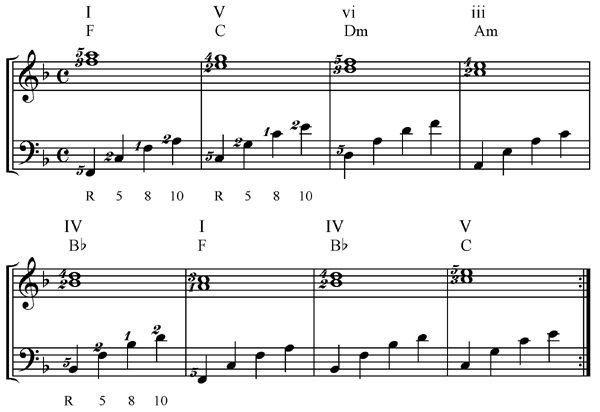
| CPM_T1_05 |
You might think the treble sounds a bit thin, up so high. Try playing the thirds an octave lower.
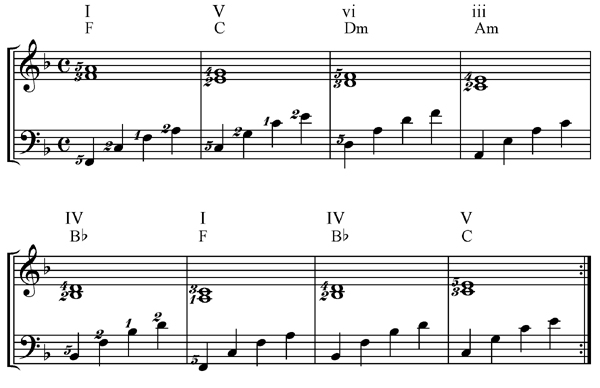
| CPM_T1_09 |
There are quite a lot of ‘clashes’ here, where the left hand has to play notes the right hand is already playing (circled in the next example). Use the sustain pedal, if your keyboard has one, and release the right hand notes just in time for the left hand to play them. The MIDI file, played on MidiPiano, shows this clearly. It is quite usual to have to ‘get out of your won way’ like this.
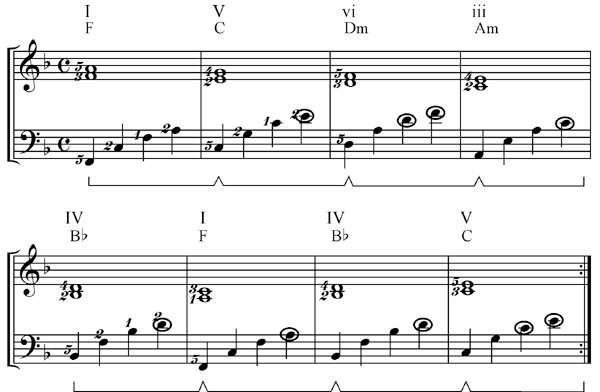
Play along with the performance file. This is also a good two-handed accompaniment for another instrumentalist to improvise over. Get a guitarist friend to put a capo on the first fret and play along using these chords:
The guitarists capo is an instant transposing device - the capo at the first fret raises the guitar chords a semitone, effectively putting the chord sequence into F major.
Transposing is the musical skill. It's said that you don't really know a chord sequence until you can transpose it - and conversely, if you want to know a chord sequence - transpose it!
|
The CANON PROJECT Pachelbel’s Canon in D is perhaps the most famous chord sequence of all time, and the basis of dozens of popular hits. If you can play and understand the Canon chord sequence, there isn’t much in popular music harmony you won’t be able to figure out! Its regular structure also makes it a great springboard for improvising and composition. |
|
Now available from Amazon Books
Click through to the Canon Project YouTube playlist here
This is the end of Part One of the Musicarta Canon Project three-module 'Transposing' mini-series. The remainder of this series is available with The Canon Project from Musicarta and on Skillshare and Udemy.
|
|
Get an overview of Musicarta in manageable monthly slices – and keep up to date with new postings.
Read all about it on the Musicarta Newsletter page. The Musicarta News - regular encouragement to learn and progress! Or – get the Musicarta RSS feed. [What’s that?] |
Thanks for visiting Musicarta.com! Come again soon!
|
OUT NOW! |
THE MUSICARTA BEAT & RHYTHM WORKBOOK At last! An effective approach to keyboard rhythm & syncopation skills. Learn more! |
ONLY $24.95! |
